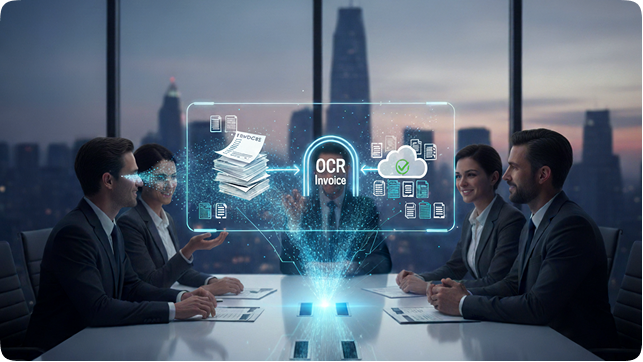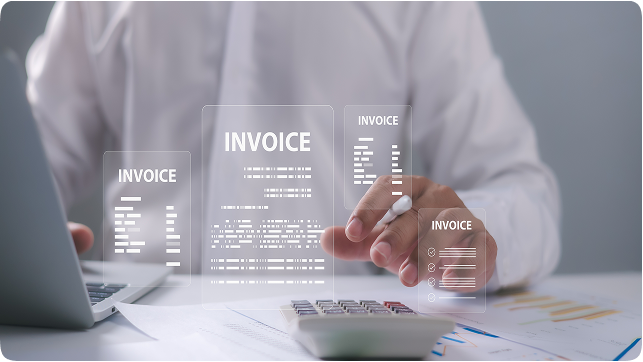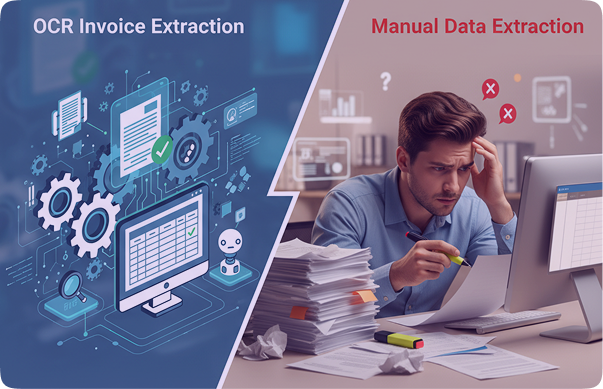Invoices are part of every business; they show what was bought, how much it cost, and who got paid. But handling them manually takes time and often leads to errors. OCR invoice extraction (Optical Character Recognition) solves this by automatically reading and capturing data from invoices, saving time and effort.
In this blog, let’s see how both methods work, how they differ, and why more businesses are switching to OCR for faster, more accurate results.
Manual Data Extraction: The Traditional Way
Manual data extraction involves individuals entering invoice information manually, such as entering vendor names, invoice numbers, and charges into spreadsheets or programs.
This is a time-consuming process, particularly if the invoices are received in non-uniform format or high quantity. This usually causes typos, delays, and additional workload to be verified
Common Steps in Manual Data Entry
1. Invoice Receipt and Sorting – Invoices arrive through different channels, email, courier, or uploaded PDFs. Teams must manually sort and categorize them before processing.
2. Manual Data Entry – Information from each invoice is entered into accounting programs or ERP systems. This can take a few minutes per invoice, depending on the format that differs among vendors.
3. Data Validation – The received data is checked and verified with purchase orders, receipts, or internal records to be accurate. Mismatched entries usually need to be followed up with the vendor or the procurement groups.
This process may work for small companies, but it becomes a challenge as invoice volumes grow. That’s where OCR steps in.

OCR Invoice Extraction: The Smarter Way
OCR automatically reads and retrieves information from scanned-in or digital invoices. It can automatically recognize fields such as supplier name, invoice date, and gross amount regardless of the format of each invoice.
Modern OCR tools use AI and machine learning to understand patterns, improving accuracy over time. Once data is extracted, it’s directly sent to your ERP or accounting system — no typing is needed.
The result: faster, cleaner, and more reliable data.
Detailed Comparison: OCR Invoice Extraction vs. Manual Data Extraction
| Aspect | OCR Extraction | Manual Data Extraction |
|---|---|---|
| Processing Speed | Processes thousands of invoices within minutes using automation. | Each invoice must be entered manually, taking several minutes per document. |
| Accuracy | Uses AI to recognize patterns and validate fields, ensuring high accuracy. | Errors can occur from fatigue, misreading numbers, or typing mistakes. |
| Scalability | Easily handles any number of invoices without extra staff. | Limited by team size and working hours. |
| Human Involvement | Humans only check exceptions or flagged errors. | Requires full-time staff for entry and review. |
| Format Adaptability | Recognizes different invoice templates and adjusts automatically. | Struggles with varied formats or handwritten invoices. |
| Cost Efficiency | One-time setup cost, then lower ongoing expenses. | Continuous labor, training, and supervision costs. |
| Compliance | Ensures consistent data records and easy audit trails. | Mistakes or missing data can cause compliance issues. |
| Integration | Connects directly with ERP or accounting systems. | Requires extra steps to transfer data from spreadsheets. |
| Data Security | Digital workflows reduce paper handling and data loss risks. | Physical copies or shared spreadsheets can be misplaced or leaked. |
| Data Consistency | Standardized extraction ensures every invoice follows the same structure. | Entries can differ by individual, causing inconsistency. |
Let’s unpack what these differences mean in real-world terms.
1. Speed and Efficiency
OCR automates data extraction, doing in seconds what takes human hours. A company that logs 10,000 invoices per month that processes invoices can save over 80% of the time it takes to process. Manual procedures rely completely on the caliber of people who can type.
2. Accuracy and Reliability
Hand-entered data is susceptible to keystroke errors or off-decimal-point placements. OCR systems, trained with AI models, minimize these mistakes by learning from corrections over time. Even better, they flag inconsistencies automatically for human review when something looks off.
3. Scalability
A human team can possibly handle so many invoices within one day. OCR systems can scale seamlessly to handle thousands more without additional people or cost escalations, making them perfect for expanding organizations.
4. Human Involvement
With OCR, people intrude only to check or to handle exceptions, not each and every one of them. That leaves the manpower free to tackle high-order activities such as vendor management or number crunching.
5. Format Flexibility
Invoices almost never appear the same. Vendors utilize varied templates, languages, as well as different tax structures. Manual entry fails to accommodate this diversity, yet OCR systems can be trained to establish habits across layouts.
6. Cost Impact
Manual data entry entails recurrent labor expenses, salaries, training, and management. OCR requires a one-time setup investment but becomes economical in the long run as it reads higher quantities with limited upkeep.
7. Compliance and Security
In finance, even small errors can cause compliance issues. Automated extraction ensures consistent formatting, traceability, and secure data storage, which simplifies audit readiness. Manual entry, in contrast, can increase the risk of lost or misfiled invoices.
8. Integration and Digitalization
OCR integrates directly with accounting, ERP, or document management systems. This enables straight-through processing without repetitive file uploads. Manual entry often requires separate steps for scanning, uploading, and data entry, slowing everything down.

Why Businesses Are Moving to Invoice OCR
Beyond efficiency, OCR brings a set of tangible benefits that directly impact financial health and operational performance. Let’s look at the crucial ones.
Improved Cash Flow Management
Automating invoice data capture enables quicker approvals and timely payments. Companies can leverage early payment discounts and late fee evasion. Real-time visibility into waiting and paid invoices also enables the finance teams to better plan the cash flow.
Example: A medium-sized manufacturing firm that had adopted OCR mentioned that they decreased invoice approval cycles from 10 to 2 days, helping them negotiate favorable vendor terms along with building stronger supplier relationships.
Real-Time Data Capture and Reporting
OCR grants online access to invoice information. This facilitates the ability to produce current reports about expenditures, outstanding payables, or vendor performance without the delay required to process manual entries.
It also facilitates the recognition of anomalies quickly, such as repeated invoices or the wrong numbers that might be missed under manual systems.
Streamlined Workflow and Faster Approvals
After data is pulled with OCR, invoices can be automatically pushed to the correct departments or approvers with integrated workflows. The chains of e-mails or paper folders are no longer passed from desk to desk.
This in most companies has increased approval rates by as high as 70%, substantially enhancing productivity.
Reduced Manual Effort and Labor Costs
As manual data entry is automated, finance departments can be smaller yet highly effective. Employees can be moved away from the mundane administrative tasks to forecasting, reconciliation, or strategic decision-making.
Insight: According to various industry studies, automating invoice processing can save up to 60–80% of labor costs, depending on the invoice volume and system integration level.
Better Data Security and Reduced Risk of Data Loss
Manual insertion typically requires numerous handoffs – printing, emailing, or transferring spreadsheets, that amplify the chance of leakage of data. OCR systems retain and process invoices programmatically within secure facilities to preserve the confidentiality as well as integrity of the data.
In industries where compliance is very strict, like finance and medicine, this computerized paper trail is a big plus.
Consistent and Reliable Data Quality
Consistency is vital to analytics as well as compliance. OCR applies the same logic and validation to each invoice such that records are the same throughout. Manual entry may differ per person, such that the format or fields will be different.

Real-World Applications
OCR invoice extraction isn’t just for large enterprises. Businesses across industries are adopting it to gain speed and accuracy:
- Retail and eCommerce: For processing hundreds of vendor invoices daily.
- Logistics and Transportation: To extract data from bills of lading, trip sheets, and delivery receipts.
- Manufacturing: To track raw material purchases and supplier payments.
- Healthcare: For automating insurance claims and billing documents.
Each of these industries benefits from faster turnaround, fewer errors, and better data visibility — all key to maintaining profitability in competitive markets.
The Future of Invoice Processing
As artificial intelligence continues to improve, OCR systems go beyond recognition of text. The latest technologies now incorporate intelligent document processing (IDP), integrating OCR with natural language processing (NLP) as well as machine learning.
This allows systems to not only extract data but also understand context — for example, distinguishing between an invoice number and a purchase order reference even if they appear similar.
The near future will see fully touchless invoicing systems that will automatically execute end-to-end workflows with minimal human interaction.
Conclusion
Manual data extraction had its time when companies dealt with fewer invoices, and the automation facilities were costly. However, in the current quick-paced, data-centric world order, it is no longer possible.
OCR invoice automation provides quicker, automated, and affordable processing — releasing finance teams from the tedium of day-in, day-out data keying so they can worry about insights and planning.
Either you are a medium-sized company fed up with spreadsheet mess, or you are a big company dealing with thousands of vendor payments, implementing OCR technology can turn your invoice processing into a hassle-free, efficient, as well as foolproof procedure.
It’s not automation — it’s shrewd commerce.
Ready to simplify your invoice processing and save time? Get in touch with us today and see how automation can work for your business!
Enhancing your workflow through
AI integration is key to future success.
processes and improve efficiency!





